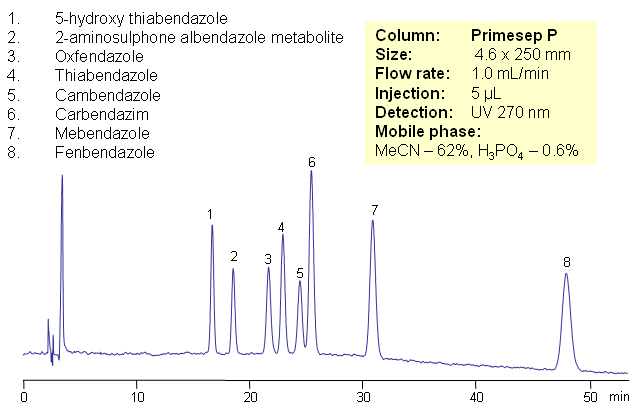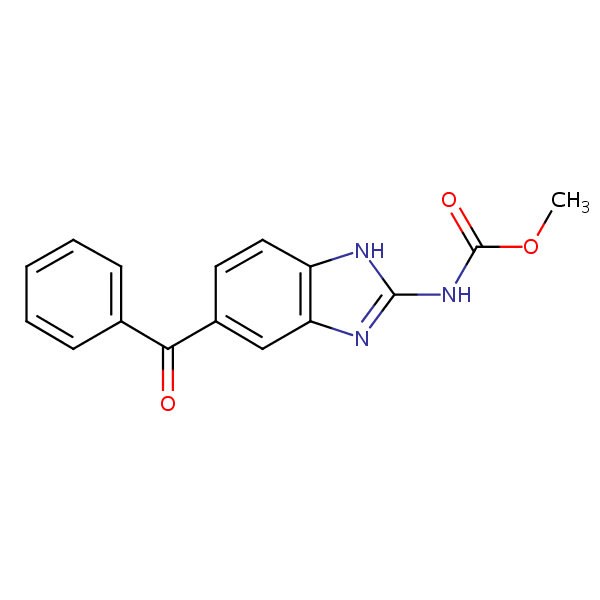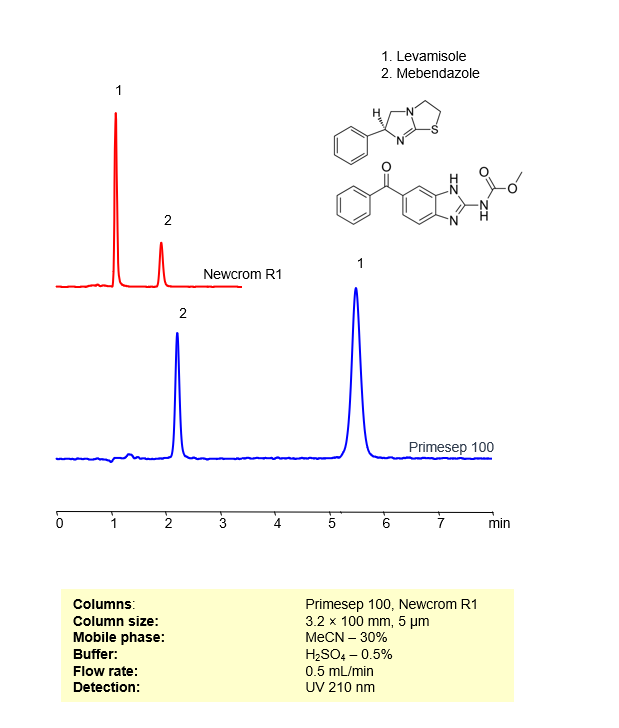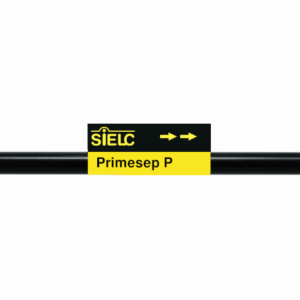| CAS Number | 31431-39-7 |
|---|---|
| Molecular Formula | C16H13N3O3 |
| Molecular Weight | 295.299 |
| InChI Key | OPXLLQIJSORQAM-UHFFFAOYSA-N |
| LogP | 2.83 |
| Synonyms |
|
Applications:
HPLC Method for Separation of Levamisole and Mebendazole in Pharmaceutical Formulations on Primesep 100 Column
June 14, 2023
HPLC Method for Separation of Levamisole, Mebendazole on Primesep 100 by SIELC Technologies
Separation type: Liquid Chromatography Mixed-mode
Levamisole and Mebendazole are both anthelmintic drugs, meaning they are used to treat parasitic worm infections. Each works in a different way and is used to treat different types of infections:
- Levamisole: This medication is used primarily to treat worm infections. It works by paralyzing the worms which are then expelled from the body by the immune system. In the past, it was also used as an immune stimulant in some types of cancer and rheumatoid arthritis. However, its use for these conditions has decreased due to the risk of serious side effects.
- Mebendazole: Mebendazole is also an anthelmintic medication used to treat a variety of parasitic worm infections, including roundworm, hookworm, whipworm, and pinworm. Mebendazole works by preventing the worms from absorbing sugars which they need to survive. This kills the worm within a few days. Although this medicine can be used for children, it should not be given to children under 2 years old.
Both drugs are typically taken orally, often as a single dose, but the exact dosage and length of treatment depend on the type of infection being treated. Like all medications, Levamisole and Mebendazole have potential side effects, and they should be used under the supervision of a healthcare provider. It’s also important to remember that hygiene practices are crucial in preventing reinfection with worms, especially in areas where such infections are common.
These compounds can be retained, separated, and analyzed using a reverse-phase Primesep 100, 3.2 x 100 mm, 5 µm, 100 A column. The mobile phase for this method consists of water, acetonitrile (MeCN), and Sulfuric acid, which serves as a buffer. This analytical method can be
High Performance Liquid Chromatography (HPLC) Method for Analysis of Levamisole, Mebendazole
Condition
| Column | Primesep 100, 3.2 x 100 mm, 5 µm, 100 A |
| Mobile Phase | MeCN -30% |
| Buffer | H2SO4 – 0.5% |
| Flow Rate | 0.5 ml/min |
| Detection | UV 210 nm |
Description
| Class of Compounds | Drug |
| Analyzing Compounds | Levamisole, Mebendazole |
Application Column
Primesep 100
Column Diameter: 3.2 mm
Column Length: 100 mm
Particle Size: 5 µm
Pore Size: 100 A
Mebendazole

HPLC Separation of Bendazoles on Primesep P Column
August 22, 2008

Eight bendazoles are separated on Primesep P HPLC column by combination of reverse phase and ion-exchange mechanisms. Primesep P column can be used when mixed-mode mechanisms, including pi-pi interactions, can benefit separation. HPLC column and method is compatible with UV detection technique.
Application Column
Primesep P
The Primesep family of mixed-mode columns offers a wide variety of stationary phases, boasting unprecedented selectivity in the separation of a broad array of chemical compounds across multiple applications. Corresponding Primesep guard columns, available with all stationary phases, do not require holders. SIELC provides a method development service available to all customers. Inquire about our specially-tailored custom LC-phases for specific separations.
Select options5-Hydroxy Thiabendazole
Albendazole
Cambendazole
Carbendazim
Fenbendazole
Mebendazole
Oxfendazole
Thiabendazole





